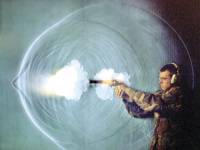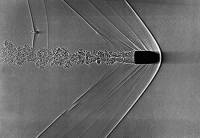MA8103 Non-Linear Hyperbolic Conservation Laws
Spring term 2020
General information
Background: In the course we study a class of nonlinear partial differential equation called hyperbolic conservation laws. These equations are fundamental in our understanding of continuum mechanical systems, and can be used to describe mass, momentum and enery conservation in mechanical systems. Examples of the use of conservation laws you may have seen in TMA4305 Partial differential equations and TMA4195 Mathematical modeling as well as in courses in physics and fluid mechanics. The equations share many properties that make numerical computations difficult. The equations may, for instance, develop singularities in finite time from smooth initial data. These equations have been extensively studied due to their importance in applications. Examples of applications include weather forecasting, flow of oil in a petroleum reservoir, waves breaking at a shore, and in gas dynamics.
Lecturers: Harald Hanche-Olsen and Helge Holden
Textbook: H. Holden and N. H. Risebro: Front Tracking for Hyperbolic Conservation Laws, Springer, Second edition 2015. The book exists as an eBook, and NTNU students can read and download it free of charge. You can purchase a paperback edition called MyCopy for € 24.95 (incl. shipping). See the upper right on the linked page.
Lecture plan
| Week | Date | Who | Material covered | |
|---|---|---|---|---|
| ◐ | means: Harald lectures | |||
| ◑ | means: Helge lectures | |||
| 3 | Fri | 17 Jan | ◑ | pp. –8. |
| 4 | Mon | 20 Jan | pp. 9–15, pp. 53–55 | |
| Fri | 24 Jan | ◐ | pp. 55–59 | |
| 5 | Mon | 27 Jan | ◑ | pp. 60–66 |
| Fri | 31 Jan | pp. 67–74 | ||
| 6 | Mon | 3 Feb | pp. 74–79 | |
| Fri | 7 Feb | ◐ | pp. 80–83 (note) | |
| 7 | Mon | 10 Feb | ◑ | pp. 84–87. Recommended exercises: Ch.2: 1,3,10,16 |
| Fri | 14 Feb | ◐ | pp. 427–430 (note on BV · updated 2020-02-21), 95–97 | |
| 8 | Mon | 17 Feb | ◑ | pp. 98–105 |
| Fri | 21 Feb | ◐ | pp. 105–109 | |
| 9 | Mon | 24 Feb | exercises; Kolmogorov–Riesz; pp. 109–110 | |
| Fri | 28 Feb | ◑ | pp. 110–115; 171–173 | |
| 10 | Mon | 2 Mar | ◐ | pp. 174–176 |
| Fri | 6 Mar | pp. 177–185 | ||
| 11 | Mon | 9 Mar | ◑ | pp. 186–188, 223–229. We skip the derivation of the shallow water equations from Navier–Stokes. |
| Fri | 13 Mar | Due to the new coronavirus situation, we are now experimenting with digital solutions. pp. 229–231: part 1 – part 2 |
||
| 12 | Mon | 16 Mar | ◐ | pp. 231–238: “slides”; pencast: part 1 · part 2 · part 3 |
| Tue | 17 Mar | pp. 238–240: “slides”; pencast: part 4 (improved resolution) | ||
| Fri | 20 Mar | ◑ | pp. 241–248: part a; part b; part c; part d | |
| 13 | Mon | 23 Mar | ◐ | pp. 249–256 (except Lemma 5.18): “slides”; pencast: part 1 · part 2 |
| Fri | 27 Mar | ◑ | pp. 256–277: part a; part b; part c | |
| 14 | Mon | 30 Mar | pp. 283–312 (no proofs): part a; part b | |
| Fri | 3 Apr | ◐ | Correspondence between Eulerian and Lagrangian formulations of conservation laws Note · “slides” · pencast: part 1 · part 2 · part 3 |
|
| 15 | Mon | 6 Apr | ◯ | Easter, no lectures |
| Fri | 10 Apr | |||
| 16 | Mon | 13 Apr | ||
| Fri | 17 Apr | ◐ | Exercises: 3.1, 3.3, 3.10; 4.1; 5.8, 5.9, 5.10 Exercise 3.1 is wrong. To fix, assume \(u^0_j=[j\le0]\) instead of \(u^0_j=[j\ge0]\) (using the Iverson bracket) For Exercise 3.10, read this before starting on it. And for Exercise 5.9, read this first. |
|
| “Slides” · pencasts: 3.1 · 3.3 · 3.10 · 4.1 (newest) · 5.8 · 5.9 (new) · 5.10 (newer) | ||||
| 17 | Mon | 20 Apr | ◑ | Sec. 4.5. pp. 212–217. lecture |
| And that's it! | ||||


